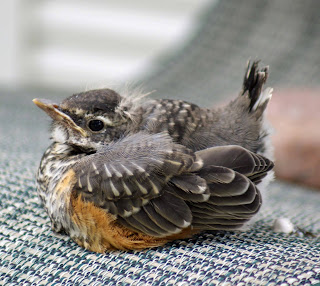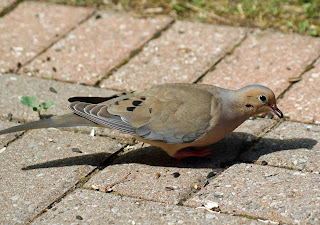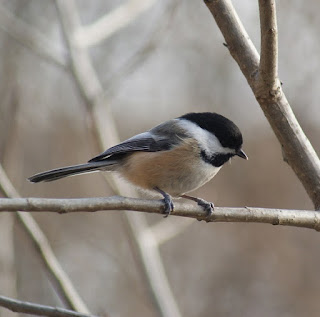Birds Make Us Happy… by Nina Munteanu
When I go out on my daily walk in the nearby meadow, woodland and marsh, I find myself listening to the birds. Their songs and calls weave a symphonic tapestry that stitches me into the very fabric of the place. Through them I find my way “home.” The iconic trill of the red-winged blackbird in the wetland calls me back to my masters studies at university when I did my field work in the marshes and fields near Lennoxville, Quebec. At my back door, the spring serenade of the robin —cheerily, cheer up, cheer up, cheerily, cheer up—calls me back to the comfort of childhood. There’s the playful chickadee-deh-deh-deh giggle of the chickadee, the sweet whistles of the yellow warbler. And then there is the echoing fluting notes of the hermit thrush; that outpouring of heaven’s light from such a tiny creature sends my own heart soaring and fills me with joy.
 | |
| A robin fledgling (All bird photos by Merridy Cox) |
All these make me joyful. All are heaven’s gift.
And I think of Robert Browning’s enduring quote: God’s in His heaven; all’s right with the world.
A recent study has correlated our happiness levels to bird diversity: the higher the number of birds, the greater our joy. This is no surprise to me.
The study by scientists at the German Centre for Integrative Biodiversity Research was published recently in Ecological Economics, reports Carly Nairn of Eco Watch. “The scientists concluded that conservation is just as important for human well-being as financial security,” writes Nairn. The study surveyed more than 26,000 adults from twenty-six European countries. From the study, the authors calculated that being around fourteen additional bird species provided as much satisfaction as earning an additional $150 a month. “A high biological diversity in our immediate vicinity is as important for life satisfaction as our income,” reports Senckenberg Biodiversität und Klima Forschungszentrum. “Biological diversity evokes happiness: more bird species in their vicinity increase life satisfaction of Europeans as much as higher income.”
 |
| A bluejay |
According to these and other researchers, birds are the best indicators of biological diversity and more bird species live in natural ecosystems such as green spaces, forested areas and bodies of water. Birds “are among the most visible elements of the animate nature – particularly in urban areas,” reports Senckenberg. “Their song can often be heard even if the bird itself is not visible, and most birds are popular and people like to watch them.”
"The happiest Europeans are those who can experience numerous different bird species in their daily life, or who live in near-natural surroundings that are home to many species," argued lead author Joel Methorst, a doctoral researcher at the Senckenberg Biodiversity and Climate Research Center, the iDiv and the Goethe University in Frankfurt.
 |
| A mourning dove |
The research findings also clearly demonstrate that bird diversity is predicated on a healthy natural ecosystem; these two are bound to each other.
Plowing of fields, deforestation, wetland draining, climate change and other land use clearing and treatments have caused great habitat loss. In addition, neonicotinoid pesticides make it harder for birds to put on weight needed for migration, delaying their travel. Our common birds make up a large part of the diversity of birds we encounter. For me just north of Toronto, this means the robin, the cardinal, sparrow, wren, blackbird, starling, junco, blue jay, chickadee, mourning dove, warbler, goldfinch, vireo, crow, osprey, hawk, and so on.
 | |
| A grackle |
These same common bird species are vital to our ecosystems. They control pests, pollinate flowers, spread seeds and help regenerate forests. When these birds disappear, their former habitats lose their functionality. “Declines in your common sparrow or other little brown bird may not receive the same attention as historic losses of bald eagles or sandhill cranes, but they are going to have much more of an impact,” said Hillary Young, a conservation biologist at the University of California. Kevin Gaston, a conservation biologist at the University of Exeter, lamented that: “This is the loss of nature.”
 |
| A chickadee |
My short story “Out of The Silence,” which appeared in the Spring 2020 issue of subTerrain Literary Magazine (Issue #85), tells the story of Katherine, a blind elder whose digital app failed to warn the world of the sudden global loss of birds with disastrous ecological consequences.
“The irony was that, once the birds vanished, the pests the fungus was originally targeted recovered with a vengeance. Some birds eat as many as 500 insects a day in the summer. Without insect-eating birds like bluebirds, wrens and chickadees to eat them, the pests exploded in numbers, causing ecosystems to collapse worldwide. 2041, which experienced an extremely warm summer, brought in swarms of grasshoppers to Asia and Europe, destroying whole harvests like a plague. I was reminded of Mao Tse Tung’s 1960 edict to kill all sparrows who were eating the seeds in the fields; instead, they caused a horrific plague of locusts that caused famine. With the disappearance of a single bird—the House Swift—agricultural pests in China quadrupled in 2041. Without the Evening Grosbeak, spruce budworm destroyed huge sections of the western forests of North America in the forties. Without the oystercatcher there to keep it in check, the Salt Marsh periwinkle destroyed a majority of the salt marshes of south-eastern USA by the late forties.
“Ironically, the pests did the most damage on the giant monocrops meant to benefit the most from the killer fungus. The ag-giants responded by dousing their wheat, maize, rice and cotton fields with even more pesticides—to which many pests had already become resistant. Instead of addressing the pests, they wiped out pollinating insects like bees and butterflies. With no pollinators, even GMO crops—like soybeans, corn, potatoes and sugar beets—failed and collapsed within a few years. China resorted to hand-pollinating their orchards. The rest of the world followed their desperate action. The price of chocolate skyrocketed when arthropods crashed the cacao agroforestry in Indonesia and the Ivory Coast. Food prices soared everywhere; soon the Foodland grocery store near where I lived grew empty. I quit drinking coffee; its price had risen to $60 a pound after the infestations of coffee plantations in Indonesia, India and Vietnam, followed by Brazil and Mexico in 2042. By the late 40s, the disappearance of insectivorous and pollinating birds meant no more apples, nuts, olives, or wine—among a host of staple foods.”
 |
| A nuthatch |
In short, a healthy diverse bird population means a healthy habitat, a healthy ecosystem AND a healthy human mind. "Nature conservation therefore not only ensures our material basis of life, but it also constitutes an investment in the well-being of us all," says Methorst.
References:
Methorst, J. et al. (2020): The importance of species diversity for human well-being in Europe. Ecological Economics, doi: 10.1016/j.ecolecon.2020.106917
Munteanu, Nina. 2020. “Out of the Silence.” subTerrain Literary Magazine, Issue 85. Vancouver, BC
Nairn, Carly. 2021. Eco-Watch.
Senckenberg Biodiversität und Klima Forschungszentrum. 2020. Online: https://www.senckenberg.de/en/pressemeldungen/biological-diversity-evokes-happiness-more-bird-species-in-their-vicinity-increase-life-satisfaction-of-europeans-as-much-as-higher-income/
You can learn more about Nina Munteanu and her book Water Is... on the website https://themeaningofwater.com/ There's more to see in the podcast "The Meaning of Writing and Water" at this link: https://www.youtube.com/watch?v=IN0j033hAXQ&feature=youtu.be


No comments:
Post a Comment